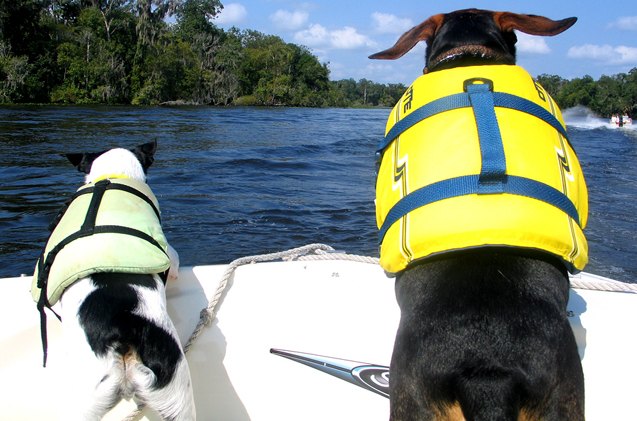Top 5 Pet Boating Blunders and How to Avoid Them

The staff at Boat Owners Association of The United States (BoatUS) have likely seen it all when it comes to boating incidents with pets, and they’ve lived to tell about it! And although they may know a thing or two about boating, it doesn’t mean they haven’t had to learn the hard way. Several members of BoatUS were kind enough to share their summer boating experiences – and in doing so, give some tips on what to do (or NOT) when taking your furry (or reptilian!) friend on an outing!
1. Be sure your pet can swim before taking him or her on board. Though it may seem that every dog intuitively knows how to swim (uh, ever heard of Doggy Paddle?), that just isn’t so! Dogs with low body fat, or age/health issues may not be the best swimmers, and it won’t be pretty if Fido should somehow fall into the water. Even if your pet is a water-loving goof, consider a life vest to be sure he or she is safe while out; swimmers get tired after a long day in the sun, and our furbabies are no different!
“As someone who has had to haul a Golden Retriever onto the swim step of a large motorboat, I’d suggest making sure the dog can swim before coming aboard the boat.” –Kerry
Related: Why Your Dog Needs A Life Jacket
2. Remember that animals can suffer from the effects of engine fumes and can become seasick. If that boat gas smell or the rocking of the waves makes you a little queasy, you should know that it can also make your pooch just as queasy! Try to make sure that your pet doesn’t feel closed in and can see out easily, preferably at the front of the boat.
“Engine fumes and seasickness can affect pets, too. Thank goodness for snap-out washable boat carpets! I try to ensure the dog is not in an enclosed space, and can see the horizon and I avoid having him sit aft where engine fumes can backdraft onto the cockpit floor. Boaters should also have a CO (carbon monoxide) alarm in the cabin regardless.”–Jerry
3. Be sure you have an emergency retrieval plan. It’s pretty well-known that cats do NOT love the water, and should they somehow end up there? They are not going to be very happy about it! Be.prepared. You’ll be glad you did!
“Cat lovers suggest hanging indoor/outdoor carpet or rope over the transom so cats can climb back aboard if they fall overboard. I once tried to dry out a wet cat with a hair dryer and it didn’t go so well. While a few cats don’t mind loud noises and may even let you vacuum them, a soft towel or chamois is better for drying off your little Lion King.”–Ted
Related: Why do cats hate water?
4) Make a boat hook part of your emergency retrieval plan. A boat hook is obviously great for docking and undocking, but it can also be a life-saving tool should your pet (or you!) fall overboard.
“I always keep a boat hook handy for retrieving just in case. It’s also easier to grab a dog when he’s wearing his lifejacket, and you can lift from the handle on his back.”–Claire in BoatUS Publications
5) Boat insurance may be needed. You never know what can happen out on the open sea. While many pets love being with their families on aqua-expeditions, not all may, and you’d be surprised at what might be necessary as a result. If you have boat insurance, make sure your pet is covered – it’ll be worth the phone call.
“In the BoatUS Marine Insurance Program’s Claims Department we recently had a claim on an iguana bite that necessitated nose reconstruction. The message? Don’t tick off the iguana.”–Kerry

More by Lori Ennis
























